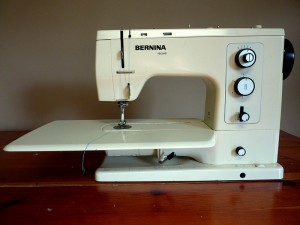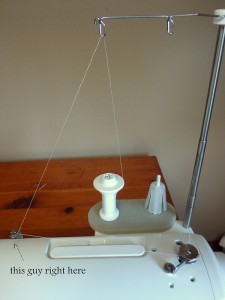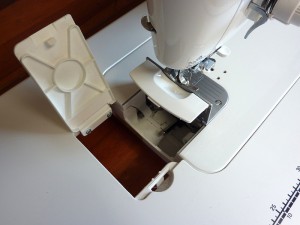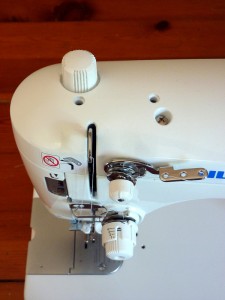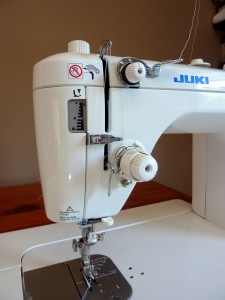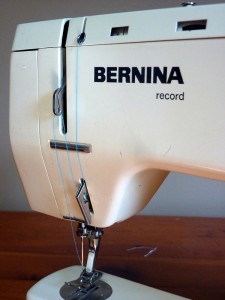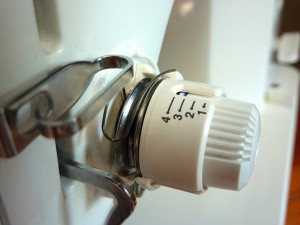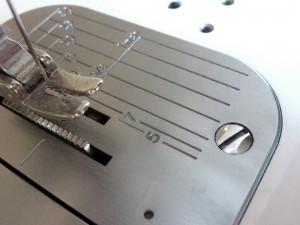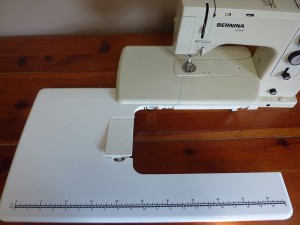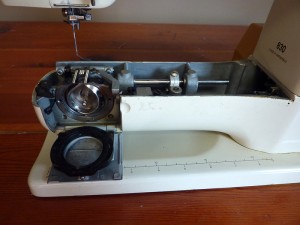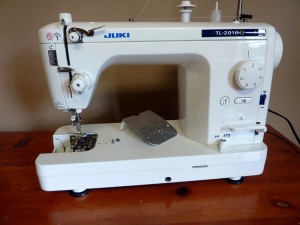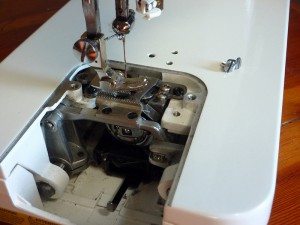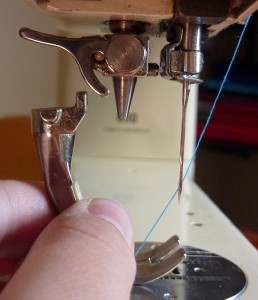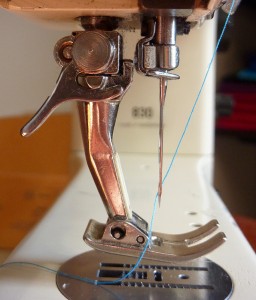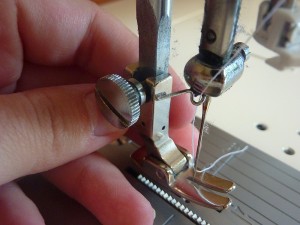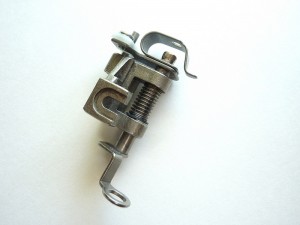A Quilter's Review of the Juki 2010
I've had my Juki 2010 for 7 months now, and felt I was comfortable enough to write down my thoughts about this machine.
I had sewn on the same machine - a classic Bernina 830 - for 20 years, so this was quite a change for me! I received the machine at the end of the week, just before a long weekend set aside specifically for sewing (as in, I had a bunch of projects due and my husband took my kids out of town for a few days so I could have some uninterrupted time). I actually didn't even set up the machine until the end of the weekend because I thought it would be difficult to get used to it. Not so! Once I learned how to thread the machine and wind bobbins, it was very easy to use. I need not have put it off. Super simple and user friendly! And so begins my relationship with this machine - only broken when the need to zig-zag arises.
For now, I'll cover the basic workings of the machine for piecing. I'll cover my thoughts on its quilting capabilities in another post.
{My overall impression}
In super brief: This machine is super powerful and fast, it and has tons of throat space. It doesn't disappoint here! These were some of the areas my first machine was lacking in and what I was most looking for in a new machine.
{My detailed observations}
Bobbin winding
There's a screw that you can adjust so that your bobbins are wound perfectly - no more uneven bobbins! As a type A person, I love this.
Unfortunately, my bobbin winder is quite finicky - it usually takes me multiple attempts of setting the winder for it to engage correctly and start actually winding. This is really frustrating - a brand new machine shouldn't be glitchy like this!
The way the winder is set up, the thread frequently pops off the - well, whatever its called (indicated in photo below) - and needs to be reset. Also frustrating.
Bobbin loading
To load the bobbin with the table on, you open a little hatch in the table before opening the bobbin hatch. It seems tight at first, but I got used to it really quickly. No complaints here. I love that you don't have to take the table off to load and unload, especially since I was used to that with my old machine.
Auto-cutter
This isn't a feature I was actually looking for in a machine, but HOLY COW it is addicting! It's a lot like getting a free DVR promotion - before I had it, I never wanted it. Now that I have it, I never want to go without it! It is a little loud, but I knew that from reviews. I didn't realize how time consuming it actually was to cut all my threads with the manual cutter on the back of my sewing machine foot, and then trim them down with a pair of snips. Having an auto-cutter has really sped up my piecing!
Liquid-stop
My old machine was a little like a car, in that it had to come to a stop. The faster I was going to begin with, the longer it took to stop. It was split seconds, really, but enough that when I was stitching quickly, I got in the habit of catching the crank wheel (on the right of the machine) to make it stop immediately. With the Juki, it just stops. The only thing is, with the needle down setting, it does need to finish its stitch. So when you're sewing along and lift your foot off the pedal, it very slowly gives one more stitch to put the needle in the down position. This isn't a problem in any way, it's just a little different for me to get used to.
Sound
People went on and on about how quiet this machine was, to the point that I was disappointed when I did get the machine. Now, it's wayyy quieter than my other machine, but I was expecting this thing to practically whisper because of the reviews. It's quiet, but it still gives a good hum. Also, the pitch of the hum changes (higher if you are going faster), which my last machine didn't do.
Threading the machine
I could thread my old machine much more quickly than this one. With the Juki, I have to pass the thread through a few holes, and take a little care while passing it through the tension disks.
My Bernina was much faster to thread as it didn't have these parts. I'm sure the Juki threading is pretty standard for machines now, but I really liked how quickly I could rethread my old machine after winding a bobbin.
Tension
Another complaint is the tension setting - it's not nearly as easy to see what the tension is set at with the Juki.
First of all, the setting knob has wiggle to it so it might look like it's set in a slightly different place than it actually is. The hashmarks are very small and close together, adding to this issue. There's a lot of cranking involved to make larger tension adjustments, and the hatches aren't very far apart, so it's a little hard to tell exactly where it's set (to remember for the future). I prefer the tension setting on my Bernina - smaller changes create a bigger difference in the tension, and it's much easier to see where it is set. In fact, I drew a little dot on the tension disk so I can see where I usually set it for FMQing. Not quite as easy with the Juki. It's a finicky complaint, but I do prefer my Bernina for this.
Seam allowance markings
Markings are in mm, but they correlate easily (the "7" marking is a 1/4" seam allowance). Given that this is a sewing machine specifically for quilting, I would have liked a 1/2" seam allowance marking, but there isn't one. When I wanted to sew with a 1/2" seam allowance (working with linens), I had to put a piece of tape on the machine to follow. Otherwise, the markings were longer and therefore easier to see than on my Bernina.
Zig-zag
This machine does not have a zig-zag setting - it's straight stitch only. I didn't think I would miss this at all, since I can just use my Bernina for straight stitching, but I actually do. 1) I don't have a separate table for my Bernina, so I have to set it up every time I want to zig-zag something. If I get another table, this problem will be solved. 2) I have started enjoying using linens in my quilting, and would probably use them more if the Juki had a zig-zag in it (I piece linens with a 1/2" seam and then zig-zag in the seam allowance). I had not used any linen before buying this machine, so I didn't realize how much I would use it. 3) Not even having the zig-zag option made me realize how often I fib a little! If my seam allowance is just a little scant (sometimes this happens when I paper-piece), I throw a zig-zag in the allowance to reinforce it instead of ripping piecing apart. This used to be a quick fix before, but isn't now! I do think I should set up another table so that my Bernina can always be set up.
Set-up/make of machine
The quilting table for this machine is wonderful - luxurious amounts of space! Here's a photo to show just how much larger the Juki and its table is:
Wow! And all of the legs are adjustable. Since my wooden table holding the machine is old and not completely flat, I love this! I can adjust it perfectly and it is nice and flush with the machine. My Bernina has a little bit of a bump where the quilting table is attached because it isn't perfectly flush. That being said, the table is actually plastic. I'm a metal snob, and wish it was metal.
Oil holes - There are a number of places you are supposed to place 1 or 2 drops when oiling your machine (daily). There are a few holes on the bed of the machine, which means you have to wipe it off every time you oil it so you don't get any on your project. I just keep a scrap of fabric tucked under the machine's handle and use that to wipe it every time. I don't find this an inconvenience at all. I will say that the oiling instructions seem a little excessive - I had to back off on the amount I was oiling the machine (I was following the instructions) because I kept ending up with oil dripping down the needle. I find that the needle location (a hole centered above the needle mechanism at the very top of the machine) only needs oil about every other day. I also oil the bobbin area less than the suggested daily dose because it's a little annoying to take it out every day. After awhile, I found that the area was quite oily anyway, and it seemed fine to oil it every time I happened to be changing the bobbin (about every 2 or 3 days). Everywhere else, I still oil daily (or every time I sew), as suggested.
Metal - All the reviews I read gushed about this being an all-metal machine. I found this to be untrue and was disappointed in how much plastic there was. The entire bottom section of the machine is covered in plastic, the right side of the machine, and most of the knobs/buttons are plastic, as well as the wheel crank. To me, this is a lot of plastic. My Bernina is from the 1970s, and has barely any plastic at all. In comparison, I don't personally consider this Juki to be an "all-metal" machine - even if it does have a lot more metal than most new machines.
Cleaning - I can pop the cover off the entire bed of my Bernina, making cleaning a breeze. It just comes off with the push of a latch. With the Juki, the bed cover does not come off. I have to use the screwdriver to remove the metal plate, and can open the bobbin hatch, but nothing else, so cleaning is not nearly as simple. As such, I don't keep it nearly as clean as my Bernina!
Here's my Bernina - with a few simple clicks, everything's open on the bottom, and the bobbin area is completely accessible:
In contrast, the Juki - only a small portion of the inner workings can be exposed for cleaning. I had to use a screwdriver to get just this much open:
I can't fit my hand into this area very well, and the bobbin is really under there, so it's hard to access!
Power
Ok, so there is nothing disappointing about the power of this machine. There is a world of difference between this machine and my Bernina! It feels like I'm driving a sports car instead of an Oldsmobile. Nuf said.
Speed
Part of this difference is due to the high speeds the Juki can stitch at - 1500 spm. My Bernina can (supposedly) go 1000 spm, which is still pretty high, but I usually didn't stitch that fast because I felt out of control. The Juki goes faster, but also affords lots of control, so I can make full use of the speed. I think part of this control is the adjustability of the presser foot pressure. I have it set as directed by the manual, so nothing crazy, but it definitely seems like there is more pressure than with my Bernina - that fabric isn't going anywhere once it gets grabbed by the foot!
Feet
The Bernina had a hook/latch system, which made it very easy to change feet.
For the Juki, I have to get out a screwdriver (or a small screwdriver-ish tool that came with the machine, as well) and loosen a screw to change feet. Some of the feet - like the 1/4" foot and the walking foot - just slide up over the screw. Others - like the FMQing foot - have a hole for the screw, so the screw needs to be removed completely. I find this a little annoying. Granted, it's not much time off my life or anything like that, but since I'm used to the convenience of my old machine's feet, this always sticks out to me as a negative.
The walking foot didn't come with a guidebar - not happy about that.
Otherwise, the feet seem really high quality - very heavy. The FMQing feet seem especially substantive and industrial in nature - I'm really impressed by them!!
***
That's all for now! Looking forward to sharing my thoughts on its quilting capabilities with you soon :)

